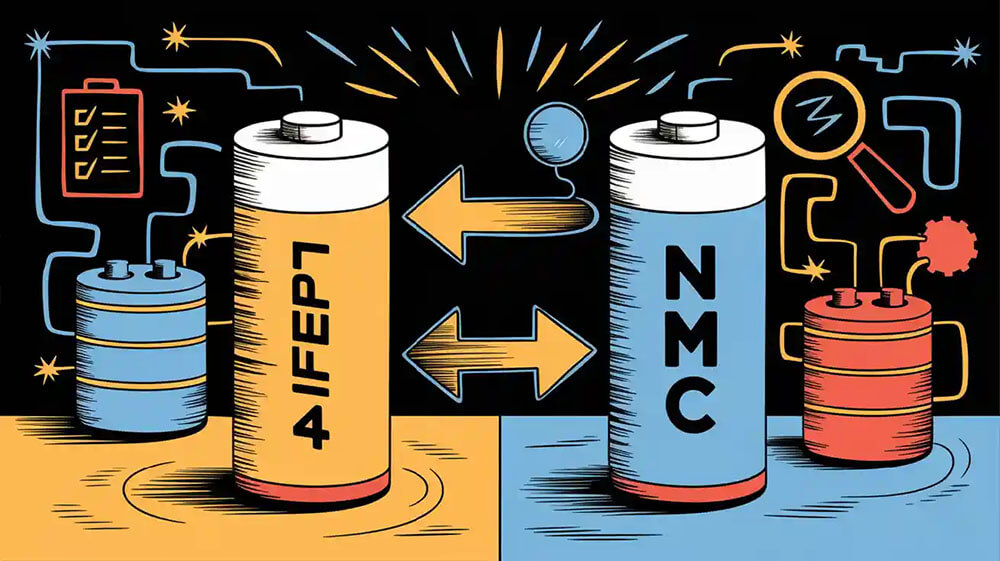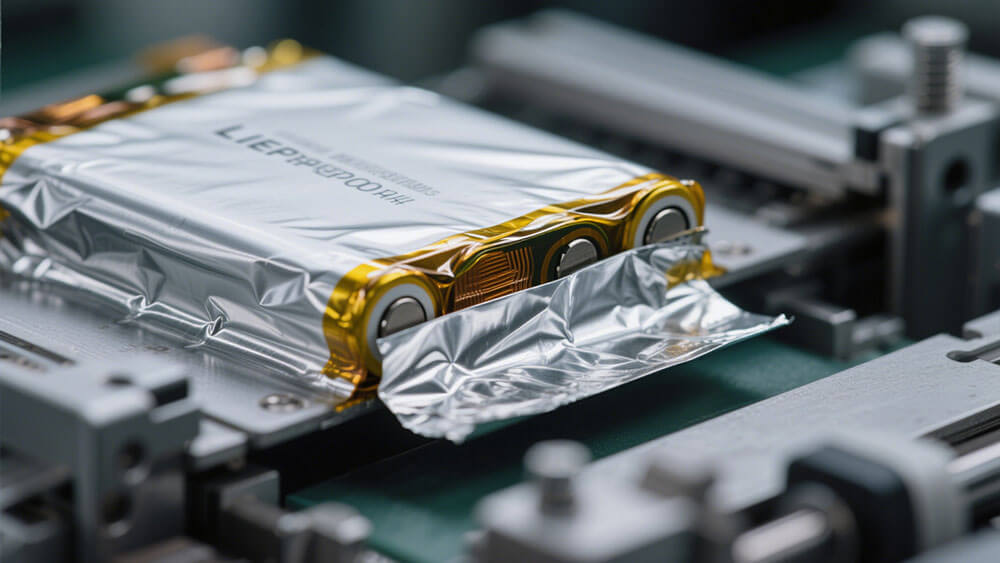Contents

Switching to LiFePO4 batteries to replace NMC batteries provides greater safety, durability, and efficiency. However, if the replacement process is not handled properly, it can result in system damage, reduced performance, or safety risks. For example, in industries such as robotics, medical devices, and infrastructure, these errors can disrupt critical operations. To fully benefit from LiFePO4 batteries, it is essential to carefully evaluate compatibility and avoid common mistakes during the replacement process.
Key Takeaways
Switching to LiFePO4 batteries makes them safer and last longer. Their stable design lowers the chance of overheating, making them great for important uses.
Be careful with voltage differences when replacing NMC batteries. LiFePO4 runs at 3.2V per cell, but NMC runs at 3.6–3.7V. Checking this helps them work well and stay safe.
Always use a charger made for LiFePO4 batteries. Wrong chargers can lower battery life and cause problems like overheating.
Part 1: Key Differences Between NMC and LiFePO4 Batteries

1.1 Chemistry and Safety of LiFePO4 vs. NMC
LiFePO4 batteries and NMC batteries differ significantly in their chemical composition and safety profiles. LiFePO4 batteries utilize lithium iron phosphate as their cathode material, which is inherently stable and resistant to thermal runaway. This stability makes LiFePO4 batteries a safer choice for applications in medical devices, robotics, and security systems.
In contrast, NMC batteries rely on nickel, cobalt, and manganese as cathode materials. While these elements provide higher energy density, they also increase the risk of overheating and combustion under extreme conditions. A study investigating thermal runaway behavior revealed that mechanical abuse, such as puncturing or squeezing, can lead to hazardous outcomes like leakage, smoke, or even fire in NMC batteries.
LiFePO4 batteries avoid these risks due to their robust intercalation mechanism, which prevents internal short circuits and heat generation. This makes them ideal for infrastructure applications like transportation systems, where safety is paramount.
1.2 Performance and Lifespan Comparison
When comparing performance, NMC batteries offer higher specific energy and energy density at the cell level. However, their theoretical advantage diminishes at the pack level. Research shows that NMC cells achieve only 36% of their theoretical performance, while LiFePO4 cells reach 45–48%.
LiFePO4 batteries also excel in lifespan. A 2020 study published in the Journal of the Electrochemical Society demonstrated that LiFePO4 cells have a longer cycle life than NMC cells. Under controlled testing conditions, LiFePO4 batteries achieved 2,000–5,000 cycles, compared to NMC’s 1,000–2,000 cycles. This extended lifespan makes LiFePO4 batteries a cost-effective choice for industrial applications.
1.3 Thermal Management and Low-Temperature Application Scenarios
Thermal management is another area where LiFePO4 batteries outperform NMC batteries. LiFePO4 batteries operate at a lower platform voltage of 3.2V, reducing heat generation during charging and discharging. This characteristic is particularly beneficial for consumer electronics, where overheating can compromise device functionality.
NMC batteries, with a platform voltage of 3.6–3.7V, require advanced cooling systems to prevent overheating. This adds complexity and cost to their integration into systems like lithium-ion battery packs.
Lithium Nickel Manganese Cobalt (NMC) and Lithium Iron Phosphate (LiFePO₄) batteries exhibit distinct behaviors in low-temperature environments.
LiFePO₄ in Low-Temperature
Capacity/Power Reduction: LiFePO₄ experiences significant capacity and power loss below 0°C due to slower lithium-ion diffusion in its olivine crystal structure.
Charging Risks: Charging below 0°C can cause lithium plating (metallic lithium deposition), leading to permanent capacity loss and safety hazards.
Voltage Drop: Lower discharge voltage at cold temperatures reduces usable energy.
NMC in Low-Temperature
Better Ionic Conductivity: NMC’s layered oxide structure allows slightly better ion mobility in cold conditions compared to LiFePO₄, retaining more usable capacity at sub-zero temperatures.
Higher Sensitivity to Thermal Stress: While less prone to lithium plating during charging, NMC’s high reactivity (due to nickel content) increases risks of accelerated degradation if operated outside ideal thermal ranges.
Part 2: Common Mistakes When Switching to LiFePO4

2.1 Voltage and Capacity Mismatches
One of the most common mistakes during a LiFePO4 replace NMC process is failing to account for voltage and capacity mismatches. LiFePO4 batteries operate at a nominal voltage of 3.2V per cell, while NMC batteries typically have a nominal voltage of 3.6–3.7V per cell. This difference may seem minor, but it can significantly impact system performance and safety.
When you replace NMC batteries with LiFePO4, mismatched voltage levels can cause improper charging and discharging cycles. For example, a system designed for NMC batteries may overcharge LiFePO4 cells, leading to overheating or reduced lifespan. Similarly, capacity mismatches can result in insufficient energy storage, which compromises the performance of applications like robotics or medical devices.
To avoid these issues, you should carefully assess the voltage and capacity requirements of your system before installation. If necessary, consult with a battery expert to ensure compatibility. Proper planning will help you maximize the performance and lifespan of your LiFePO4 battery system.
2.2 Using an Incompatible Charger
Using a charger not specifically designed for LiFePO4 batteries is another critical mistake. LiFePO4 batteries have unique charging profiles that differ from those of NMC or other lithium-ion batteries. Chargers designed for NMC batteries often operate at higher voltages, which can damage LiFePO4 cells or prevent them from reaching full capacity.
Key Risks of Using an Incompatible Charger:
The battery may not achieve its full capacity, reducing overall performance.
Overcharging can lead to overheating, which compromises safety protection.
To prevent these problems, always use a charger that matches the specifications of your LiFePO4 battery. Many manufacturers provide chargers tailored to LiFePO4 systems, ensuring optimal performance and safety. If you’re unsure about compatibility, consult the technical documentation or seek professional advice.
2.3 Neglecting Battery Management System (BMS) Requirements
Neglecting the requirements of a Battery Management System (BMS) is a mistake that can have severe consequences. The BMS plays a critical role in monitoring and protecting your LiFePO4 battery system. It ensures proper voltage regulation, prevents overcharging, and detects faults early to avoid catastrophic failures.
Without a suitable BMS, your battery system becomes vulnerable to issues like thermal runaway, which can lead to fires or explosions. Technical documentation highlights that neglecting BMS requirements often results in increased replacement costs and reduced safety protection. For example:
Faults may go undetected, leading to battery degradation or system failure.
The absence of a BMS increases the risk of overheating, especially in high-demand applications like industrial equipment or robotics.
To ensure a safe and efficient transition, you must install a BMS compatible with your LiFePO4 battery. A well-designed BMS will enhance the performance and lifespan of your system while providing critical safety features. For custom solutions tailored to your specific needs, consider consulting with experts like Large Power.
Part 3: Best Practices for a Safe and Efficient Transition

3.1 Conducting a System Compatibility Assessment
Before replacing your current batteries with LiFePO4, you must evaluate your system’s compatibility. LiFePO4 batteries operate at a nominal voltage of 3.2V per cell, which differs from the 3.6–3.7V of NMC batteries. This voltage variation can impact the performance of your equipment if not properly addressed.
Start by reviewing the voltage, capacity, and energy storage requirements of your application. For example, industrial systems often demand higher energy storage and consistent performance under heavy loads. If your system was designed for NMC batteries, you might need to adjust the configuration or integrate additional components to ensure compatibility.
Consulting with a battery expert or using professional tools for compatibility assessment can save time and prevent costly errors. For custom solutions tailored to your specific needs, consider reaching out to experts like Large Power.
3.2 Installing a Proper Battery Management System
A robust Battery Management System (BMS) is essential for the safe and efficient operation of LiFePO4 batteries. The BMS monitors critical parameters such as voltage, current, and temperature, ensuring optimal protection and performance.
When transitioning to LiFePO4, select a BMS specifically designed for this chemistry. A generic BMS may fail to provide adequate protection, leading to issues like overcharging or thermal runaway. For applications in robotics or medical devices, where safety and reliability are paramount, a high-quality BMS is non-negotiable.
Additionally, ensure the BMS supports the unique charging profile of LiFePO4 batteries. This step will maximize the lifespan of your battery system while maintaining consistent performance.
3.3 Capacity and Physical Considerations
LiFePO4 batteries often differ in size and capacity compared to NMC batteries. Before installation, verify that the physical dimensions of the replacement batteries fit within your system’s design. For example, infrastructure applications like transportation systems may require custom battery enclosures to accommodate LiFePO4 cells.
Capacity is another critical factor. LiFePO4 batteries typically have a lower energy density than NMC batteries but offer a longer lifespan and better thermal stability. To achieve the desired energy storage, you may need to adjust the number of cells or modify the system layout.
Proper planning and consultation with experts will ensure a seamless transition. If you’re looking to replace lead-acid batteries with LiFePO4, this process becomes even more critical due to the significant differences in chemistry and performance.
Switching to LiFePO4 batteries offers improved safety, durability, and efficiency compared to NMC batteries. Avoiding mistakes like voltage mismatches or neglecting a proper BMS ensures a smooth replacement process. Adopting best practices, such as system compatibility assessments, minimizes operational errors. For example, managing temperature variations improves fault detection accuracy, enhancing battery performance and safety.
FAQ
1. How do LiFePO4 batteries compare to NMC batteries in terms of safety?
LiFePO4 batteries are safer due to their thermal stability and resistance to overheating. They are ideal for applications like medical devices and robotics.
2. Can I use my existing charger for a LiFePO4 battery?
No, you need a charger specifically designed for LiFePO4 batteries. Using an incompatible charger can damage the battery or reduce its lifespan.
3. What industries benefit most from LiFePO4 batteries?
Industries like infrastructure, consumer electronics, and industrial sectors benefit due to LiFePO4’s durability, safety, and long lifespan.
Tip: For professional guidance on LiFePO4 battery configurations, visit Large Power.





